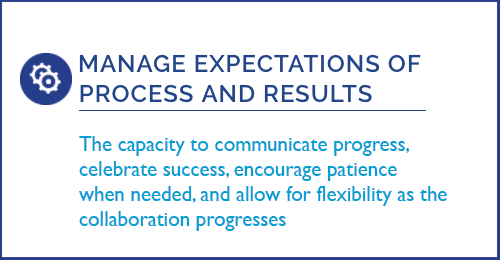Jun 06 2017 Diving Into The Intersector Toolkit: Manage Expectations of Process and Results
 We recently updated our Toolkit for Intersector Collaboration to provide even more useful advice to practitioners involved in cross-sector collaborations. We’re profiling each of our 17 tools on our blog, with a focus on resources that can help collaborations succeed.
We recently updated our Toolkit for Intersector Collaboration to provide even more useful advice to practitioners involved in cross-sector collaborations. We’re profiling each of our 17 tools on our blog, with a focus on resources that can help collaborations succeed.
Communicating progress toward goals, as well as recognizing when to adapt to changing circumstances, new information, and shifting priorities, allows collaborations to maintain engagement and momentum. These practices, components of the tool Manage Expectations of Process and Results, are particularly important for initiatives that involve multiple sectors, as they often take longer than expected, in part because partners must work in ways that take into account the practices and priorities of other sectors. Collaborations can encourage patience among partners by communicating progress and celebrating success, which instills confidence and commitment. Partners can do this by beginning meetings with progress updates, sending reports of progress to partners on a regular basis, organizing an event to celebrate the achievement of a milestone, or seeking external opportunities (via media outlets, external stakeholder meetings, etc.) to share interim achievements.
How should partners decide which milestones to celebrate? The discussion of Milestones and Critical Events on pp. 31-33 of the University of Wisconsin Cooperative Extension’s “Evaluating Collaboratives: Reaching the Potential” provides helpful guidance and checklists for partners to identify milestones, such as developing a collaborative vision and securing funding or other resources, to be celebrated as signs of progress. Also see the discussion of Levels of Outcomes (found on pp. 113-117), which includes a helpful explanation of immediate, intermediate, and final outcomes. Immediate and intermediate outcomes — such as improved school attendance and reduction in behavioral reports — can be documented and celebrated throughout the duration of a collaborative’s work, on the path to final outcomes — such as a reduction in high school drop-out rates.
When partners are confident in the collaboration’s progress, they are more apt to be flexible in planning and to adjust to changing circumstances, new information, and shifting priorities. To learn more about adaptive planning processes appropriate for addressing complicated problems, see the “Adaptive Planning Toolkit” from Spark Policy Institute. Adaptive planning encourages continuous learning and an openness to shifting strategy over the course of a project. This resource outlines three major steps in adaptive planning: clearly defining the results; exploring the context and your assumptions; and engaging in strategy and action planning.
Partners should also monitor how their intentions align with their accomplishments — both to keep the partnership on track and to communicate progress or the need to change course to partners and stakeholders. For help with this, they can see pp. 43 – 47 of the European Commission’s “Partnership Development Toolkit.” While not all templates in this section will be relevant to all collaborations, Template 7: Quarterly Monitoring Record (found on p. 45) provides a useful framework for assessing progress. This template records planned and actual “monitoring areas,” such as outputs, activities, and stakeholder behavior. Where planned and actual monitoring areas match, the collaboration can report successes. The resource also helps partners to briefly explain causes and remedies for any variances between planned and actual monitoring areas.
For guidance on assessing partnering organizations’ communications practices and needs, as well as those of its internal and external stakeholders, see Tool 3: Needs Analysis for Individual Partners in The Partnering Initiative’s “Talking the Walk” (found on p. 74). We suggest partners use this information to guide them in communicating progress in a way that is valuable to the differing stakeholder groups of each partner. This tool can either be used by leaders to guide dialogue among partners, or for information gathering from individual partners, as the tool can serve as a framework for a questionnaire that each partner representative can complete and later share with the collaborative.
See Manage Expectations of Process and Results in our Toolkit for further discussion on this topic, questions to guide tool use, and more.
Explore the full Toolkit and each of the 17 tools with enhanced discussion, questions to guide tool use, and additional resources here.
